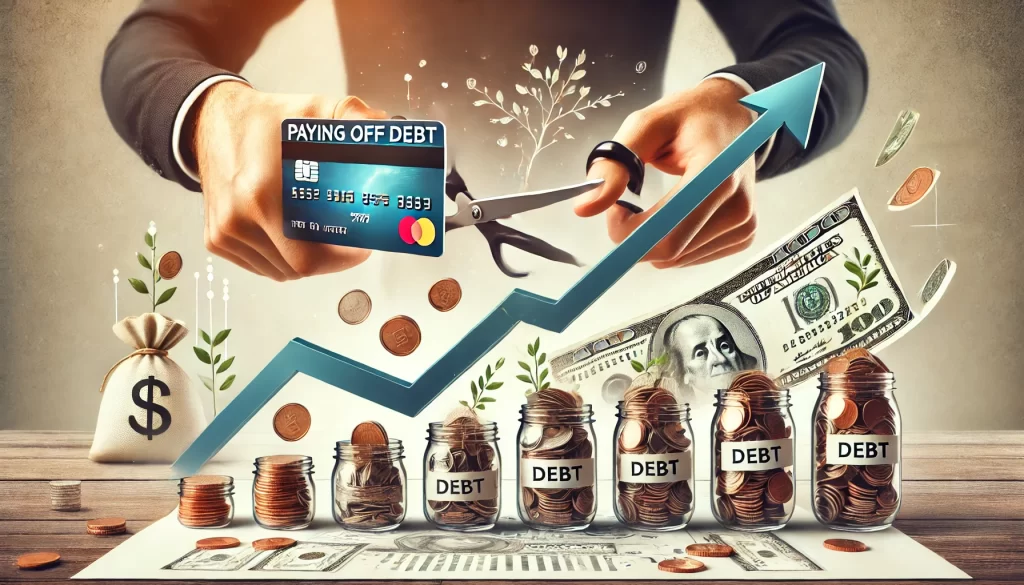Imagine standing at the base of a huge mountain of debt. Each bill is like a boulder, making your financial load heavier. The journey to financial freedom seems tough, but the choice of path matters a lot. You can either use the Avalanche method for precision or the Snowball method for quick wins.
The Snowball method starts with the smallest debts first. This gives you quick victories that boost your motivation. On the other hand, the Avalanche method targets high-interest debts to save money over time. Both are effective debt repayment strategies but suit different financial situations.
Before starting, make sure you have a solid base. An emergency fund is crucial, and keeping your current accounts in order is key. As you pay off debt quickly, your credit score will improve, helping you become more financially stable.
The Snowball method can cut down your repayment time by half, saving you thousands in interest. The Avalanche method might save a bit more but takes a similar amount of time. The goal is to get out of debt and enjoy financial freedom.
At the crossroads of Snowball and Avalanche, your financial journey starts. With a good plan and determination, you’ll reach the top. Let’s explore these strategies further, aiming for the peak where your financial future awaits.
Understanding the Debt Snowball and Avalanche Strategies
Chasing debt-free goals can seem like a maze. But, the Debt Snowball and Debt Avalanche offer clear paths. By getting out of debt fast, knowing these methods is key.
The Debt Snowball method is great for motivation. It starts with small debts, giving quick wins. This method doesn’t look at interest rates but focuses on debt size. It helps build momentum as each debt is paid off.
The Debt Avalanche method, on the other hand, targets high-interest debts first. It saves money over time by reducing interest payments. This method requires patience but is very effective in the long run.
Both methods can help get out of debt fast, depending on your situation. They offer structured ways to pay off debts and teach better financial management.
Tools like debt calculators and budgeting apps can help too. They show how each payment impacts your debt. For personalized advice, consider a financial advisor.
Knowing the psychological and financial sides of each method helps choose the right one. Whether it’s the quick wins of the Debt Snowball or the savings of the Debt Avalanche, the goal is the same: financial freedom.
How to Implement the Debt Snowball Method for Faster Wins
Starting a debt-free journey needs a solid plan, and the debt snowball method is perfect. It helps you reduce debt fast and keeps you motivated as you clear each debt.
Establish Your Debt List From Smallest to Largest
First, list your debts from smallest to largest. This step helps you focus on paying off debts quickly. It gives you a sense of accomplishment with each debt you clear.
Creating a Budget to Pay Off Debt Quickly
Create a budget that allocates additional funds to the debt with the smallest balance while maintaining minimum payments on other debts. This is key to paying off debts fast. By managing your budget well, you can tackle debts quicker without hurting your finances.
Maintaining Momentum with Each Paid Account
When you pay off a debt, the money goes to the next smallest one. This creates a snowball effect. It keeps you motivated to pay off all your debts.
Financial Peace University found that families can pay off about $5,300 in debt in 90 days using the snowball method. People have even paid off $40,000 in 18 months. Dave Ramsey also uses this method in his 7 Baby Steps, proving it’s effective for long-term financial health.
Navigating the Debt Avalanche Method for Maximum Savings
Looking to accelerate debt payoff and create a financial freedom plan? The Debt Avalanche method is a great choice. It focuses on paying off high-interest debts first. This not only speeds up your debt repayment but also saves you a lot on interest.
Prioritizing Debts by Interest Rate
To save on interest, it’s key to Allocate extra funds to the debt with the highest interest rate while maintaining minimum payments on other debts. This way, you tackle the most expensive debts first. For example, paying off a credit card with 22.24% APR before a student loan at 6.3% can save you a lot of money in the long run.
Allocating Extra Funds to Reduce Debt Fast
This method is not just about high-interest rates. It also means consistently allocating extra funds towards these debts. Every extra payment you make cuts down the principal amount. This, in turn, reduces the interest you pay over time. This focused approach is one of the fastest ways to pay off your debt and achieve financial freedom.
Evaluating Progress and Adjusting Payments
It’s vital to continuously monitor and evaluate debt repayment progress. Adjust your plan as needed to stay on track. Once a debt is paid off, move those funds to the next highest interest account. This keeps your repayment process efficient and maintains momentum.
This methodical approach helps manage your financial burden and leads to financial freedom. With each debt cleared, you get closer to a more secure financial future. It’s all about smart financial practices and disciplined spending.
Assessing Pros and Cons of Each Method to Pay Off Debt Quickly
Choosing the right strategy to pay off debt quickly is key to reaching debt-free goals and starting a financial freedom plan. The Debt Snowball and Avalanche methods have their own benefits and drawbacks. They depend on your financial situation and what you prefer.
The Debt Snowball is great for those who want quick wins to stay motivated. It focuses on the smallest debts first, giving you fast progress. But, it might cost more in interest over time compared to other methods.
The Debt Avalanche, on the other hand, aims to save the most on interest by tackling high-rate debts first. It’s best for those who value financial efficiency over quick emotional wins.
Both methods need patience and discipline. The Snowball method boosts your mood by clearing debts quickly. The Avalanche method takes longer but saves more on interest, leading to better financial health.
Choosing between Debt Snowball and Avalanche depends on your financial habits, goals, and emotional needs. Each method can help you pay off debt quickly in its own way. It’s about finding what fits your financial behavior and debt situation best.
Conclusion
Starting to pay off debt quickly offers several paths. You can go for the debt snowball, focusing on the smallest balances first. Or, you can choose the debt avalanche, which targets high-interest rates. This method can save you money over time.
Choosing the right approach depends on your financial goals. It could be paying off a $40,000 student loan in 18 months. Or, it might be about improving your credit score. The key is to find a method that works for you.
When you pick a method, remember to budget and cut costs. You could take on a side job to earn more. Or, you could negotiate bills to save money. Consolidating debts under one rate can also help.
Reaching your goal of being debt-free is a big accomplishment. It’s important to stay on track and make smart spending choices. Whether you pick debt snowball or avalanche, the goal is to find a way that works for you.
Remember, your path to financial freedom is unique. It depends on your debt and income. But, by staying committed and making smart choices, you can achieve financial stability. This will bring you peace of mind.






